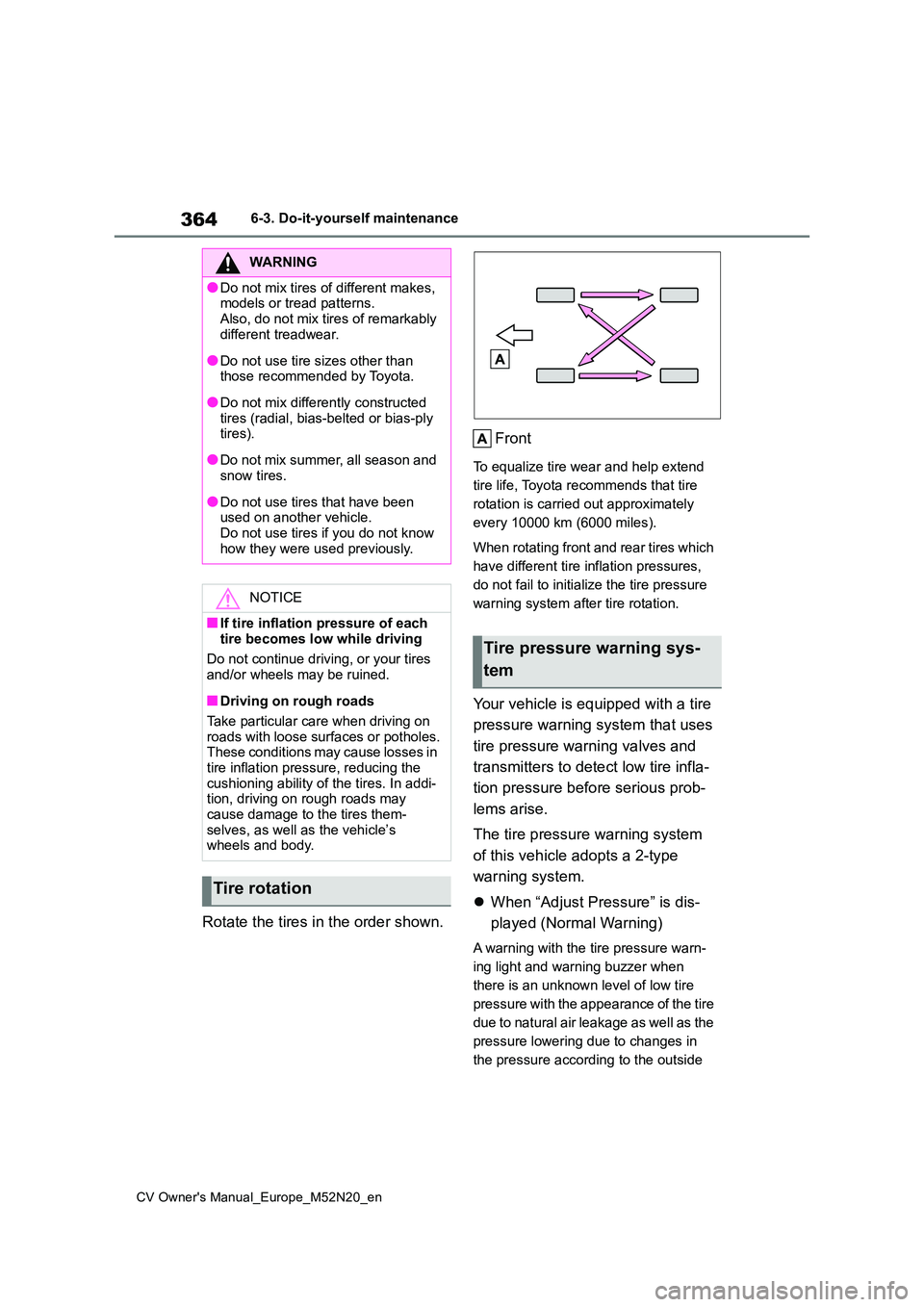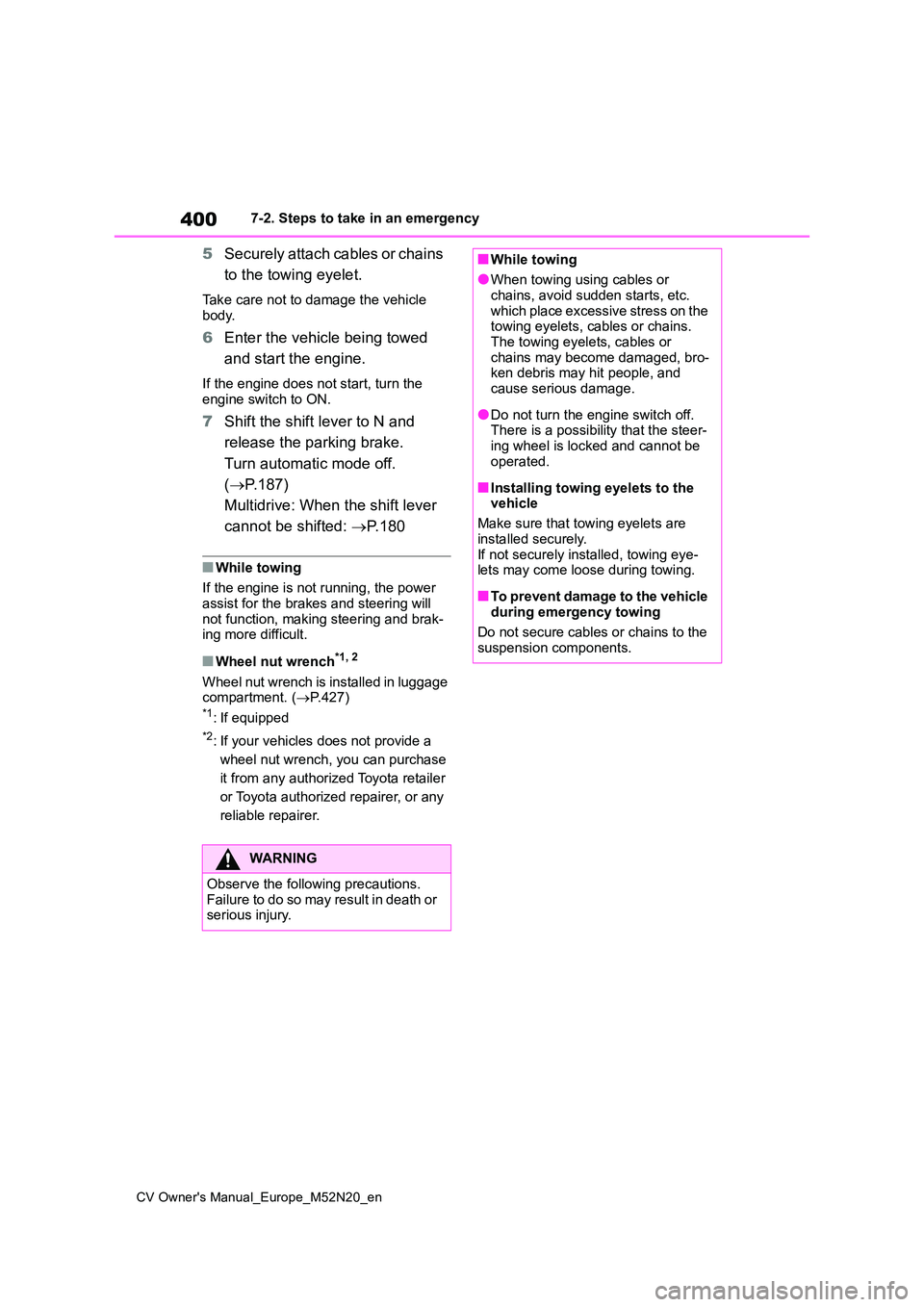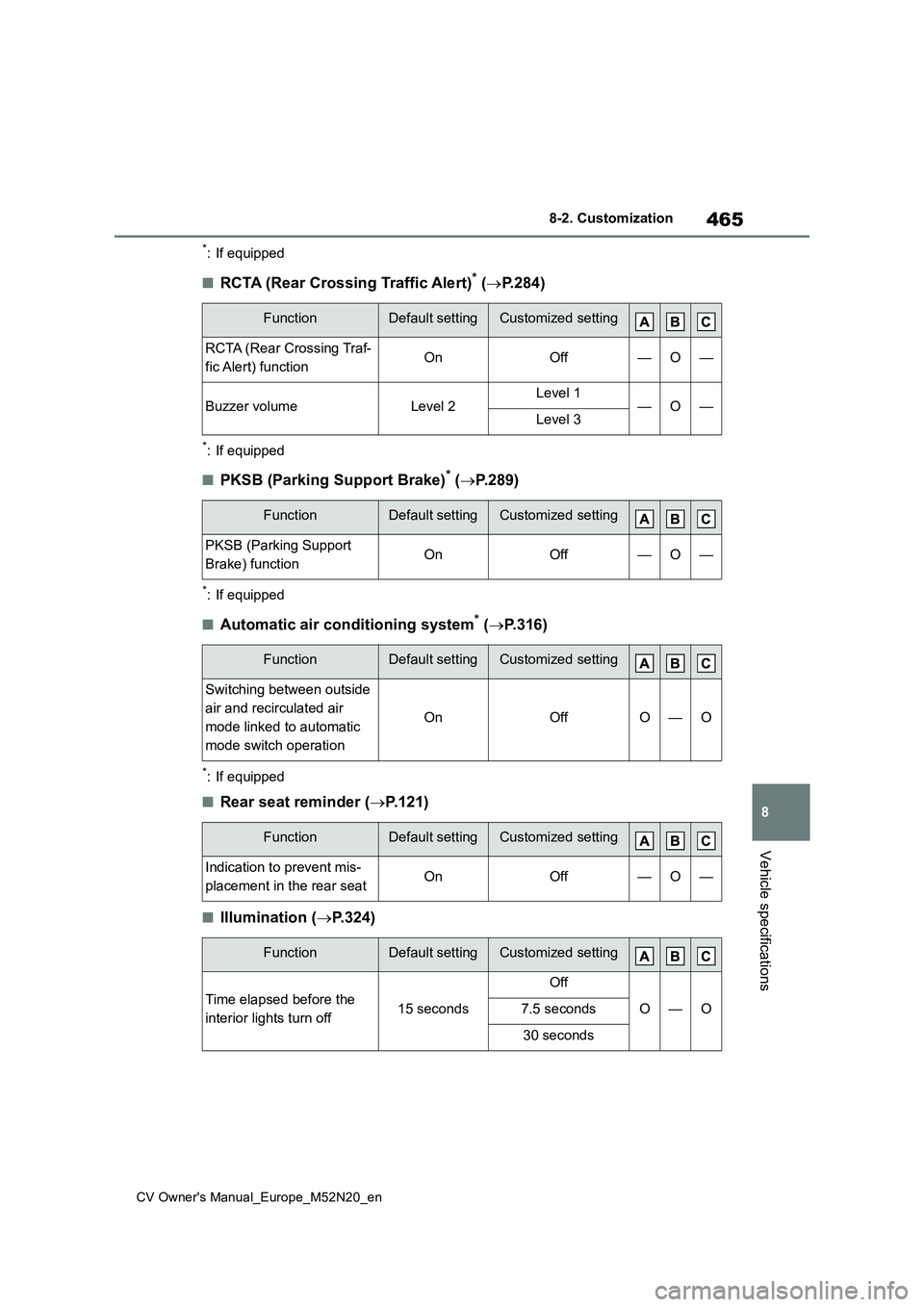2022 TOYOTA YARIS CROSS ECO mode
[x] Cancel search: ECO modePage 366 of 618

364
CV Owner's Manual_Europe_M52N20_en
6-3. Do-it-yourself maintenance
Rotate the tires in the order shown.
Front
To equalize tire wear and help extend
tire life, Toyota recommends that tire
rotation is carried out approximately
every 10000 km (6000 miles).
When rotating front and rear tires which
have different tire inflation pressures,
do not fail to initialize the tire pressure
warning system after tire rotation.
Your vehicle is equipped with a tire
pressure warning system that uses
tire pressure warning valves and
transmitters to detect low tire infla-
tion pressure before serious prob-
lems arise.
The tire pressure warning system
of this vehicle adopts a 2-type
warning system.
When “Adjust Pressure” is dis-
played (Normal Warning)
A warning with the tire pressure warn-
ing light and warning buzzer when
there is an unknown level of low tire
pressure with the appearance of the tire
due to natural air leakage as well as the
pressure lowering due to changes in
the pressure according to the outside
WARNING
●Do not mix tires of different makes, models or tread patterns.
Also, do not mix tires of remarkably different treadwear.
●Do not use tire sizes other than those recommended by Toyota.
●Do not mix differently constructed tires (radial, bias-belted or bias-ply tires).
●Do not mix summer, all season and snow tires.
●Do not use tires that have been used on another vehicle.
Do not use tires if you do not know how they were used previously.
NOTICE
■If tire inflation pressure of each
tire becomes low while driving
Do not continue driving, or your tires and/or wheels may be ruined.
■Driving on rough roads
Take particular care when driving on roads with loose surfaces or potholes.These conditions may cause losses in
tire inflation pressure, reducing the cushioning ability of the tires. In addi-tion, driving on rough roads may
cause damage to the tires them- selves, as well as the vehicle’s wheels and body.
Tire rotation
Tire pressure warning sys-
tem
Page 402 of 618

400
CV Owner's Manual_Europe_M52N20_en
7-2. Steps to take in an emergency
5Securely attach cables or chains
to the towing eyelet.
Take care not to damage the vehicle
body.
6 Enter the vehicle being towed
and start the engine.
If the engine does not start, turn the
engine switch to ON.
7 Shift the shift lever to N and
release the parking brake.
Turn automatic mode off.
( P.187)
Multidrive: When the shift lever
cannot be shifted: P. 1 8 0
■While towing
If the engine is not running, the power assist for the brakes and steering will
not function, making steering and brak- ing more difficult.
■Wheel nut wrench*1, 2
Wheel nut wrench is installed in luggage compartment. ( P.427)*1: If equipped
*2: If your vehicles does not provide a
wheel nut wrench, you can purchase
it from any authorized Toyota retailer
or Toyota authorized repairer, or any
reliable repairer.
WARNING
Observe the following precautions. Failure to do so may result in death or serious injury.
■While towing
●When towing using cables or chains, avoid sudden starts, etc.
which place excessive stress on the towing eyelets, cables or chains. The towing eyelets, cables or
chains may become damaged, bro- ken debris may hit people, and cause serious damage.
●Do not turn the engine switch off.There is a possibility that the steer-
ing wheel is locked and cannot be operated.
■Installing towing eyelets to the vehicle
Make sure that towing eyelets are
installed securely. If not securely installed, towing eye-lets may come loose during towing.
■To prevent damage to the vehicle during emergency towing
Do not secure cables or chains to the suspension components.
Page 412 of 618

410
CV Owner's Manual_Europe_M52N20_en
7-2. Steps to take in an emergency
■Slip indicator
■Parking brake indicator
■Brake hold operated indicator (warning buzzer)
■Warning buzzer
In some cases, the buzzer may not be heard due to being in a noisy location or
audio sound.
■Front passenger detection sensor, seat belt reminder and warning buzzer
●If luggage is placed on the front pas-senger seat, the front passenger
detection sensor may cause the warn- ing light to flash and the warning buzzer to sound even if a passenger
is not sitting in the seat.
●If a cushion is placed on the seat, the
sensor may not detect a passenger,
and the warning light may not operate properly.
■If the malfunction indicator lamp comes on while driving
For some models, the malfunction indi- cator lamp will come on if the fuel tank becomes completely empty. If the fuel
tank is empty, refuel the vehicle immedi- ately. The malfunction indicator lamp will
go off after several trips.
If the malfunction indicator lamp does not go off, contact any authorized Toyota
retailer or Toyota authorized repairer, or any reliable repairer as soon as possi-ble.
Warning lightDetails/Actions
Indicates a malfunction in:
The VSC system;
The TRC system; or
The hill-start assist control system
Have the vehicle inspected by any authorized Toyota
retailer or Toyota authorized repairer, or any reliable
repairer immediately.
Warning lightDetails/Actions
(Flashes)
It is possible that the parking brake is not fully engaged or
released
Operate the parking brake switch once again.
This light comes on when the parking brake is not released. If the
light turns off after the parking brake is fully released, the system is
operating normally.
Warning lightDetails/Actions
(Flashes)
Indicates a malfunction in the brake hold system
Have the vehicle inspected by any authorized Toyota
retailer or Toyota authorized repairer, or any reliable
repairer immediately.
Page 440 of 618

438
CV Owner's Manual_Europe_M52N20_en
7-2. Steps to take in an emergency
1Vehicles with a Multidrive:
Ensure that the shift lever is in P
and depress the brake pedal.
Vehicles with a manual trans-
mission: Shift the shift lever to N
and depress the clutch pedal.
2 Touch the area behind the lock
button and unlock button on the
electronic key to the engine
switch.
When the electronic key is detected, a
buzzer sounds and the engine switch will turn to ON.
When the smart entry & start system is
deactivated in customization setting, the engine switch will turn to ACC.
3 Firmly depress the brake pedal
(Multidrive) or clutch pedal
(manual transmission) and
check that is shown on the
multi-information display.
4 Press the engine switch shortly
and firmly.
In the event that the engine still
cannot be started, contact any
authorized Toyota retailer or Toyota
authorized repairer, or any reliable
repairer.
■Stopping the engine
Shift the shift lever to P (Multidrive) or N
(manual transmission) and press the engine switch as you normally do when stopping the engine.
■Electronic key battery
As the above procedure is a temporary measure, it is recommended that the electronic key battery be replaced
immediately when the battery is depleted. ( P.378)
■Alarm (if equipped)
Using the mechanical key to lock the
doors will not set the alarm system. If a door is unlocked using the mechani-cal key when the alarm system is set,
the alarm may be triggered. ( P. 7 7 )
■Changing engine switch modes
Release the brake pedal (Multidrive) or clutch pedal (manual transmission) and
press the engine switch in step 3 above. The engine does not start and modes will be changed each time the switch is
pressed. ( P.177)
WARNING
■When using the mechanical key and operating the power win-
dows
Operate the power window after checking to make sure that there is no
possibility of any passenger having any of their body parts caught in the window.
Also, do not allow children to operate the mechanical key. It is possible for children and other passengers to get
caught in the power window.
Starting the engine
Page 443 of 618

441
7
CV Owner's Manual_Europe_M52N20_en
7-2. Steps to take in an emergency
When trouble arises
entry & start system when the battery
is discharged. Use the wireless remote control or the mechanical key to lock or unlock the doors.
●The engine may not start on the first attempt after the battery has
recharged but will start normally after the second attempt. This is not a mal-function.
●The engine switch mode is memo-rized by the vehicle. When the battery
is reconnected, the system will return to the mode it was in before the bat-tery was discharged. Before discon-
necting the battery, turn the engine switch off.If you are unsure what mode the
engine switch was in before the bat- tery discharged, be especially careful when reconnecting the battery.
●The Stop & Start system may not automatically stop the engine for up to
an hour.
■When replacing the battery
●Use a battery that conforms to Euro-
pean regulations.
●Use a battery that the case size is
same as the previous one, 20 hour rate capacity (20HR) is equivalent or greater, and performance rating
(CCA) is equivalent or greater. Check the label on top of the battery for the battery size and specifications (ex.
LN2, 60Ah, 345A). • If the sizes differ, the battery cannot be properly secured.
• If the 20 hour rate capacity is low, even if the time period where the vehi-cle is not used is a short time, the bat-
tery may discharge and the engine may not be able to start.
●For details, consult any authorized Toyota retailer or Toyota authorized repairer, or any reliable repairer.
WARNING
■When removing the battery ter-minals
Always remove the negative (-) termi- nal first. If the positive (+) terminal contacts any metal in the surrounding
area when the positive (+) terminal is removed, a spark may occur, leading to a fire in addition to electrical shocks
and death or serious injury.
■Avoiding battery fires or explo-
sions
Observe the following precautions to prevent accidentally igniting the flam-
mable gas that may be emitted from the battery:
●Make sure each jumper cable is connected to the correct terminal and that it is not unintentionally in
contact with any other than the intended terminal.
●Do not allow the other end of the jumper cable connected to the “+” terminal to come into contact with
any other parts or metal surfaces in the area, such as brackets or unpainted metal.
●Do not allow the + and - clamps of the jumper cables to come into con-
tact with each other.
●Do not smoke, use matches, ciga-
rette lighters or allow open flame near the battery.
■Battery precautions
The battery contains poisonous and corrosive acidic electrolyte, while
related parts contain lead and lead compounds. Observe the following precautions when handling the bat-
tery:
Page 467 of 618

465
8
CV Owner's Manual_Europe_M52N20_en
8-2. Customization
Vehicle specifications
*: If equipped
■RCTA (Rear Crossing Traffic Alert)* (P.284)
*: If equipped
■PKSB (Parking Support Brake)* (P.289)
*: If equipped
■Automatic air conditioning system* (P.316)
*: If equipped
■Rear seat reminder (P.121)
■Illumination (P.324)
FunctionDefault settingCustomized setting
RCTA (Rear Crossing Traf-
fic Alert) functionOnOff—O—
Buzzer volumeLevel 2Level 1—O—Level 3
FunctionDefault settingCustomized setting
PKSB (Parking Support
Brake) functionOnOff—O—
FunctionDefault settingCustomized setting
Switching between outside
air and recirculated air
mode linked to automatic
mode switch operation
OnOffO—O
FunctionDefault settingCustomized setting
Indication to prevent mis-
placement in the rear seatOnOff—O—
FunctionDefault settingCustomized setting
Time elapsed before the
interior lights turn off15 seconds
Off
O—O7.5 seconds
30 seconds
Page 477 of 618

475
CV Owner's Manual_Europe_M52N20_en
Alphabetical Index
Display
Dynamic radar cruise control ..... 250
Dynamic radar cruise control with
full-speed range ....................... 238
Head-up display ......................... 106
LTA (Lane-Tracing Assist) .......... 234
Multi-information display ...... 94, 100
Speed limiter .............................. 261
Toyota parking assist-sensor ..... 277
Warning message ...................... 413
Display change button ............. 87, 92
Distance until next engine oil change
................................................. 87, 92
Do-it-yourself maintenance ......... 348
Door
Double locking system ................. 76
Door lock
Back door ................................... 123
Side doors .................................. 119
Smart entry & start system......... 136
Wireless remote control ............. 116
Doors
Back door ................................... 123
Door glasses .............................. 153
Door lock ............................ 119, 123
Open door warning buzzer. 120, 122
Outside rear view mirrors ........... 150
Rear door child-protectors ......... 123
Side doors .................................. 119
Double locking system .................. 76
Drive distance ......................... 98, 103
Drive information .................... 98, 103
Driving ........................................... 158
Break-in tips ............................... 160
Correct driving posture................. 33
Driving mode select switch ........ 299
Procedures................................. 158
Winter drive tips ......................... 307
Driving information display ... 96, 101
Driving range................... 96, 101, 102
Driving support system information
display ...................................97, 103
Dynamic radar cruise control ...... 250
Road Sign Assist (RSA) ............. 257
Warning message ...................... 259
Dynamic radar cruise control with
full-speed range.......................... 238
Road Sign Assist (RSA) ............. 246
Warning message ...................... 248
E
eCall ................................................. 65
“SOS” button ................................ 65
Eco drive mode .............................299
Eco Driving Indicator...... 96, 102, 109
Eco Driving Indicator Light ....96, 102
Elapsed time............................98, 103
Electric Power Steering (EPS) ..... 301
Warning light .............................. 406
Electronic key ............................... 114
Battery-saving function............... 137
If the electronic key does not operate
properly .................................... 437
Replacing the battery ................. 378
Emergency brake signal .............. 301
Emergency flashers...................... 394
Emergency tire puncture ............. 415
Emergency, in case of
If a warning buzzer sounds ........ 403
If a warning light turns on ........... 403
If a warning message is displayed
................................................. 413
If the battery is discharged ......... 439
If the electronic key does not operate
properly .................................... 437
If the engine will not start ........... 435
If the vehicle is trapped in rising
water ........................................395
Page 478 of 618

476
CV Owner's Manual_Europe_M52N20_en
Alphabetical Index
If you have a flat tire........... 415, 426
If you lose your keys .................. 436
If you think something is wrong.. 401
If your vehicle becomes stuck .... 444
If your vehicle has to be stopped in
an emergency .......................... 394
If your vehicle needs to be towed
................................................. 397
If your vehicle overheats ............ 442
Engine ........................................... 449
ACC ................................... 173, 177
Compartment ............................. 354
Engine switch ..................... 173, 174
Fuel pump shut off system ......... 402
Hood .......................................... 351
How to start the engine ...... 173, 174
Identification number.................. 449
If the engine will not start ........... 435
If your vehicle has to be stopped in
an emergency .......................... 394
Ignition switch (engine switch) . 173,
174
Overheating ............................... 442
Tachometer .................... 85, 89, 109
Engine coolant .............................. 356
Capacity ..................................... 452
Checking .................................... 356
Preparing and checking before win-
ter ............................................ 307
Engine coolant temperature gauge
................................................. 85, 89
Engine immobilizer system ........... 75
Engine oil ...................................... 354
Capacity ..................................... 450
Checking .................................... 354
Preparing and checking before win-
ter ............................................ 307
Warning light .............................. 404
Engine oil maintenance data ....... 356
Engine switch........................ 173, 174
Auto power off function .............. 177
Changing the engine switch modes
......................................... 173, 177
If your vehicle has to be stopped in
an emergency .......................... 394
EPS (Electric Power Steering) ..... 301
Warning light .............................. 406
Extended headlight lighting function
..................................................... 194
F
Flat tire
Tire pressure warning system .... 364
Vehicles with a spare tire ........... 426
Vehicles without a spare tire ...... 415
Floor mats ....................................... 32
Fluid
Brake .......................................... 453
Clutch ......................................... 453
Multidrive .................................... 452
Washer ....................................... 362
Fog lights
Switch......................................... 204
Wattage ...................................... 455
Front fog lights
Switch......................................... 204
Wattage ...................................... 455
Front position lights
Replacing light bulbs ..................387
Wattage ...................................... 455
Front seat center airbags ............... 38
Front seats .................................... 141
Adjustment ................................. 141
Cleaning ..................................... 345
Correct driving posture ................. 33
Head restraints ........................... 144
Seat heaters ............................... 322